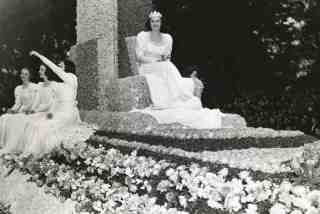Tennis : Helen Wills Moody Roark Attracts Attention Again, Thanks to Martina
- Share via
Whether or not Martina Navratilova wins an unprecedented ninth Wimbledon singles title Saturday, her quest has served to re-focus attention on the 82-year-old co-holder of the record, Helen Wills Moody Roark.
Roark, who was Helen Wills Moody when she defeated Helen Jacobs, 6-4, 6-0, in the 1938 Wimbledon final to win her eighth singles crown, attracted renewed interest last summer when Navratilova won her eighth Wimbledon singles championship with a straight-set victory over Steffi Graf in the final.
Should Navratilova surpass the Wimbledon mark, there won’t be any sadness or dismay at the home of Roark in Carmel, Calif.
“No,” Roark said, “I think anybody who wins at Wimbledon deserves to win.”
Navratilova’s impending accomplishment has created a new wave of fascination with Helen Wills Moody and her famous French rival, Suzanne Lenglen. There is a book on both players that was published by Oxford Press last month, titled, “The Goddess and the American Girl,” released to coincide with Navratilova’s attempt to break the record. And later this year, work will begin on a movie about Lenglen’s life.
This is the upside--or downside, depending on how you look at it--of fame the second time around. The book has sparked a bit of controversy, at least in one quarter.
In previous interviews, and also with The Times, Roark was outspoken in her dislike for the book.
Some examples:
--”It seemed to me to have many errors. It was rather unpleasant. . . . There were errors about every other page. I don’t think I was ever something for a hyped-up book. My life is an open book and rather dull at that.”
--”I think they (Oxford) had better stick to dictionaries (rather) than to sports they don’t know anything about.”
--”I don’t think a person who is not a sportswriter can write about sports. What do you think?”
When asked to give examples of mistakes in the text, Roark didn’t point out any specific errors. Larry Engelmann has heard the complaints and has responded with some consternation mixed with amusement, especially at Roark’s dismissal of him because of a non-sportswriting background.
Engelmann probably could have seen that trouble was ahead when he embarked on the project. He said Roark discovered that he was writing a book about her and tried to persuade friends not to talk to him, because she was convinced he was going to write a “Kitty Kelley-type book.”
Instead, the work is anything but. Englemann became interested in writing about the two women when he was researching the 1920s and ‘30s for his first book, “Intemperance: The Lost War Against Liquor.” Much to his surprise, he found that historians neglected to examine the lives of Lenglen and Wills, despite definitive works on other major sports figures of the era.
He spent several years researching, interviewing and corresponding with a variety of people, including Kitty McKane Godfree, who beat Wills in the Wimbledon final in 1924; Helen Hull Jacobs, who carried on an intense rivalry with Wills, and Fred Moody, her first husband.
For a tennis fan or anyone interested in that period, the book is an excellent and thorough account of the two women, their matches and the tremendous impact they had on women’s tennis. What surprised Engelmann most was how quickly the two were forgotten.
“I wrote the book about two people who are not minor figures,” he said. “They were well-known throughout the world. But now nobody seems to know much about them.
“My publisher approached the Book of the Month Club, and they said, ‘Who?’ You certainly realize to some degree how quickly they were forgotten.”
But not by all. Engelmann heard or read that, as a little boy, the Washington Post’s Ben Bradlee slept with a racket that Wills had given him. Englemann wrote to Bradlee asking about the story and received a long letter detailing his recollections of Wills.
Wrote Bradlee: “ . . . She had in fact given me a racket--a Gold Star, I remember--the handle of which she autographed. I played with it, and then after the head started to warp, kept it on. I don’t remember sleeping with it, but probably I did. I was thrilled.”
Bradlee wasn’t the only one to become enthralled with Wills. In the book, Englemann recounts how Charlie Chaplin once described Wills playing tennis as the most beautiful thing he had ever seen. And Mexican muralist Diego Rivera, struck by her beauty and personality, thought that she represented California better than anyone and that the state was known abroad mainly because of her accomplishments. She was his inspiration for a mural in the Pacific Coast Stock Exchange in San Francisco, which he started painting in 1930.
“The night before Helen played Suzanne in France (in 1926, a match that Lenglen won), there was a prize fight at Madison Square Garden,” Englemann said. “They asked for a moment of silent prayer for Helen. They said something like, ‘Say a prayer for our little Helen in France.’
“So, can you imagine television cutting in to show Martina serving in the last game, as she is going to break the record? Can you imagine interrupting the Cosby show?”
As for Helen Wills Moody Roark, she’ll be watching Navratilova attempt to break the record--at home in front of the television. She was invited to Wimbledon but could not make the long trip because of her health. Recently, Roark had a tough battle with the flu but is feeling better.
“Oh, I will take care of myself,” she said. “I have to. Or I’ll be in the graveyard.”
Roark will, however, have one souvenir of this year’s championships.
“When I had to mail my tickets back to them, I told them I was going to keep my badge,” she said. “After all, it has my name on it. I don’t think anyone else would want to wear it. I told them I’m going to wear it during the tournament.”
More Suzanne, Hollywood style: Apparently, filming of “The Suzanne Lenglen Story” is scheduled to begin this fall in Paris and London. Gene Corman, president of Chateau Productions, has cast Karen Baldwin as Lenglen.
Baldwin, whose credits include such films as “The Witching Hour” and “Jigsaw,” is lesser-known than two of the movie’s minor players, Bud Collins and Frank Deford. Collins is a tennis analyst for NBC and a columnist in the Boston Globe. Deford, an award-winning writer, is with Sports Illustrated and NBC.
In the movie, Collins will portray sportswriter John Tunis, who covered Lenglen’s matches for the Globe. Deford will play Al Laney, a Herald Tribune reporter in Paris.
Tennis Notes
Although the Slims of San Diego has boosted its prize money--to $100,000 from $75,000 in 1987--there will be competition elsewhere on the women’s circuit the same week, Aug. 1-7, unlike in other years. The competing $250,000 tournament is at Kings Island, Ohio, where it will precede the men’s ATP Championships. Many of the top players have committed to the ATP event, including Mats Wilander, Stefan Edberg, Jimmy Connors and Pat Cash. So far, the highest-ranked women players to commit to play the previous week are Terry Phelps and Helen Kelesi. At this point, San Diego has a stronger field with Lori McNeil, Bettina Bunge, Stephanie Rehe and Patty Fendick. McNeil will also play in the Virginia Slims of Los Angeles at Manhattan Beach, as will Zina Garrison. Chris Evert, Martina Navratilova, Pam Shriver, Gabriela Sabatini and Hana Mandlikova already have made commitments to Manhattan Beach. . . . The Southern California Tennis Assn. will conduct instructional clinics for players age 8-18 at various locations, starting the week of July 11. These clinics will be held at 85 sites throughout Southern California. For more information, call (213) 208-3838.
More to Read
Go beyond the scoreboard
Get the latest on L.A.'s teams in the daily Sports Report newsletter.
You may occasionally receive promotional content from the Los Angeles Times.











